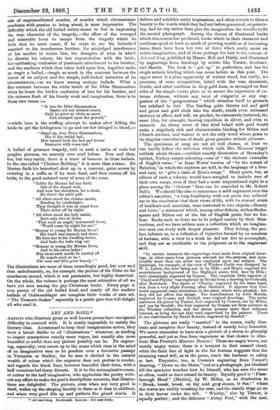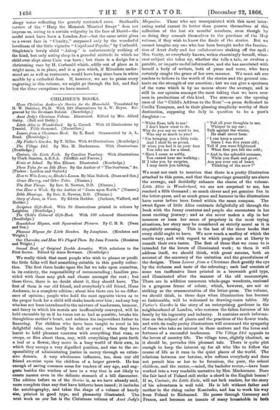ART AND SONG.• ARTISTS who illustrate great or well known
poems have one special difficulty to contend with. It is nearly impossible to satisfy the literary class. Accustomed to keep their imaginations active, they have a latent dislike to all "illustrations " whatever, as tending to impair conceptions usually more vague, but usually also more beautiful or awful than any picture possibly can be. No engrav- ing, especially, ever comes up to the scene which rises in the mind of an imaginative man as he ponders over a favourite passage in Tennyson or Shelley, for he sees it clothed in the natural wealth of colour which the engraver does not profess to render, and regards the black lines, however beautiful their form, with a half conscious but sharp distaste. It is to the unimaginative mass, or rather to the half imaginative, who appreciate the poetry with- out any effort to make the poet's descriptions concrete, that illustra- tions are delightful. The picture, even when not very good in itself, wakes up the sleeping faculty in them as it does in children, and when very good fills up and perfects the grand words. It
• Art and k'oog. Illustrated. London : Bel and Daldy.
defines and solidifies misty impressions, and often reveals to them a beauty in the words which they had not before perceived, or perceiv-
ing, had let slip rather than give the imagination the trouble to fix the mental photograph. Among the dozens of illustrated books which this season has produced, books which in their character and costliness speak at least as much of growing wealth as of increasing taste, there have been but two or three which really assist an active imagination, and of these perhaps the best is the volume of Art and Song, published by Messrs. Bell and Daldy, and illustrated by engravings from drawings by artists like Turner, Stothard,
and Martin. The book is "got up" to perfection, and has the single artistic binding which has come before us this year. The upper cover is a plate apparently of walnut wood, but really, we presume, of some composition, inlaid with the rose, shamrock, thistle, and other emblems in deep gold lines, so arranged on four sides of the simple centre plate as to secure the impression of ex- treme richness, without any taint of vulgarity or any sug- gestion of the " gorgeousness " which attaches itself to grounds less subdued in tint. The binding quite throws red and gold and green and gold cloth into the shade, excels even embossed morocco in effect, and will, we predict, be extensively imitated, the same idea, for example, bearing repetition in silver, and even in enamels. An ebony cover of this kind inlaid with gold would make a singularly rich and characteristic binding for Bibles and Church services, and walnut is not the only wood whose grain in its singular convolutions of shade gives genuine artistic pleasure.
The specimens of song are not all well chosen, at least we can hardly follow the criticism which calls Mrs. Hentans' turgid rubbish about Ocean,—rubbish exactly illustrative of Macaulay's epithet, Turkey-carpet colouring—one of " the choicest examples of English verse ; " or Isaac Watts' version of " by the waters of Babylon," in which the captives are told, in the language of a free- and-easy, to "give a taste of Zion's songs." Many poets, too, as editors of such a volume, would have scrupled to include two of their own songs, even if they had a more unquestioned right to a place among the " choicest " than can be conceded to Mr. Robert Bell's. We should like also to commence a mild argument over the editor's assertion, "a long familiarity with our poets has reduced me to the conclusion that their views of life, with its eternal crush of incidents and emotions, were narrowed to two objects—Beauty and Love," a statement which, among other defects, strikes Shake- speare and Milton out of the list of English poets, but we for- bear. Books such as these are to be judged mainly by their illus- trations, and we have seldom seen a collection which an imagina- tive man can study with deeper pleasure. They belong, the pre- face informs us, to a collection of vignettes formed by an amateur of fortune, with a view to a work he did not live to accomplish, and they are as creditable to his judgment as to the engravers' skill.
"In certain instances the engravings wore made from original draw- ings, in other oases from pictures selected for the purpose, and occa- sionally more than one artist was employed upon one subject. The landscape, for example, of the view of Windsor Castle was designed by W. L. Leitch, the deer being put in by Hills ; and Bright supplied the mountainous background of the Highland scene, with deer by Hills ; both charmingly engraved by Oonsen. The exquisite little vignette of Cupid and Psyche' was engraved by Stocks from a drawing by Corbould, after Bartolozzi. The figure of Charity,' engraved by the same hand, was from a very slight drawing after Stothard. It appears that Cor- bould suggested some alterations in the plate, which were adopted ; but they did not affect the design. The contributions by John Martin, engraved by Cousen and Goodall, were original drawings. The series embraces six pieces by Turner, four engraved by Cousen, one by Miller, and one by Goodall ; the four engraved by 00t18011 are from pictures in the Windsor collection, and the plates possess more than ordinary interest, as being the last that were supervised by the painter. There is one contribution by David Roberts, engraved by Goodall."
The pictures are really " married " to the verses, really illus- trate and complete their beauty, instead of merely being beautiful. We never remember to have seen a picture of a storm so gloomily powerful, and yet so free from vagueness as that chosen to illus- trate Miss Proctor's Miserere Deanne! Those are angry waves, not merely angry water, there is a tempest in that massed cloud, while the faint line of light in the far horizon suggests that the straining vessel will, as in the poem, reach the harbour in safety at last. Exquisite, too, is Cousen's engraving from Turner's drawing, " Down on the Shore," real as a photograph, yet idealized till the spectator wonders how he himself, who has seen the scene so often, could so have missed its beauty. Equally good is "Flaw- borough Head" (Martin), by W. Miller, as an illustration to " Break, break, break, on thy cold grey stones, 0 Sea! " where the waves are visibly breaking for ever, and the stately ships go on to their haven under the bill. " Whitby," also by Turner, is equally perfect ; and the delicious " Abbey Pool," with the cool, sleepy water reflecting the gravely contented cows. Stothard's version of the " Harp the Monarch Minstrel Swept" does not impress us, owing to a certain vulgarity in the face of David—the model must have been a London Jew—but the same artist gives us a sweet face in "Charity," surpassed only by the wonderful loveliness of the little vignette " Cupid and Psyche," by Corbould. Singleton's lovely child " Asleep" is unfortunately nothing of the kind, but only acting sleep in a graceful attitude in which no child ever slept since Cain was born ; but there is a design for a christening vase by H. Corbould which, oddly out of place as it Might seem, is in place, and is a gem which, if Ritualists under- stood art as well as vestments, would have long since been in white mar"ble by a cathedral door. If, however, we are to praise every engraving in this volume, we might go through the list, and find but the three exceptions we have named.



































 Previous page
Previous page